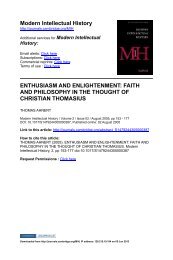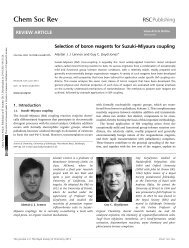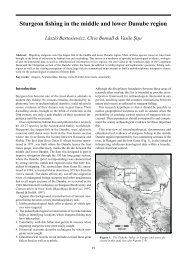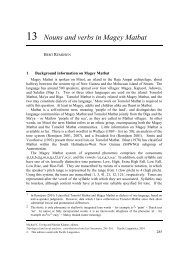Retistruct: Reconstruction of Flat-mount <strong>Retina</strong>edata consisted of cell counts within defined boxes on <strong>the</strong> flattenedretina. Here we used kernel regression (KR) as <strong>the</strong> source <strong>for</strong> <strong>the</strong>contouring algorithm (Figure 5D; see Supplemental Materials <strong>and</strong>Methods, Text S1, <strong>for</strong> details). The Karcher mean of <strong>the</strong> datapoints is represented by <strong>the</strong> magenta <strong>and</strong> cyan diamonds in ei<strong>the</strong>rplot <strong>and</strong> <strong>the</strong> peak density <strong>for</strong> <strong>the</strong> kernel is represented by <strong>the</strong> bluediamond. It is worth noting that <strong>the</strong>se two measures often givedifferent locations, as would be expected from skewed distributions.Obtaining uni<strong>for</strong>m <strong>and</strong> complete injections of tracer into <strong>the</strong>dLGN can be difficult <strong>and</strong> can result in variability in <strong>the</strong> pattern oflabel (e.g. <strong>the</strong> contralateral retinae in Figure 6A). We have takenadvantage of st<strong>and</strong>ard retinal space to measure <strong>the</strong> extent of <strong>the</strong>ipsilateral projection by making a composite plot of data from 7different animals (Figure 5E), which shows that <strong>the</strong> averageipsilateral projection occupies a crescent in ventrotemporal retina.The decussation line <strong>for</strong> <strong>the</strong> aggregate ipsilateral population is64.161.6u from <strong>the</strong> retinal pole, which in <strong>the</strong>se 7 animals is veryclose to <strong>the</strong> optic disc. The distance from <strong>the</strong> optic disc to <strong>the</strong>decussation line is 63.461.3u (Figure 5F). The ipsilateral crescentspans an average of 134.161.5u of <strong>the</strong> rim extending from22.161.3u beyond <strong>the</strong> temporal pole to 22.061.5u beyond <strong>the</strong>ventral pole (Figure 5G).Trans<strong>for</strong>mation to visuotopic coordinatesThe geometry of binocular vision implies that <strong>the</strong> ipsilateraldecussation line should correspond to <strong>the</strong> vertical meridian in <strong>the</strong>adult mouse’s visual field [3,6]. In order to investigate thisprediction, we sought to map <strong>the</strong> retina onto visual space. Themapping of visual space onto <strong>the</strong> retina is determined by <strong>the</strong>orientation of <strong>the</strong> optic axis <strong>and</strong> <strong>the</strong> optics of <strong>the</strong> eye. We assumethat <strong>the</strong> optic axis corresponds to <strong>the</strong> retinal pole of <strong>the</strong> sphericalretinal coordinate system. Thus <strong>the</strong> optic axis is close to but notcoincident with <strong>the</strong> optic disc. The location of <strong>the</strong> optic disc hasbeen estimated to be projected to a point 60u lateral to <strong>the</strong> vertical<strong>and</strong> 35u above <strong>the</strong> horizontal meridian in anaes<strong>the</strong>tised mice [14].Alternatively, <strong>the</strong> optic axis has been reported to be 64u lateral to<strong>the</strong> vertical <strong>and</strong> 22u above <strong>the</strong> horizontal meridian in ambulatorymice [15]. In anaes<strong>the</strong>tised mice, Dräger <strong>and</strong> Hubel noted that <strong>the</strong>eyes were always diverted outwards [1].In principle, <strong>the</strong> deviation of a ray by <strong>the</strong> eye can be estimatedby means of a schematic model of <strong>the</strong> mouse eye [19,20]. WeFigure 5. Measurement of <strong>the</strong> ipsilateral projection. A, Schematic illustrating <strong>the</strong> retinal label resulting from bilateral injections of Fluoro-Ruby(magenta) <strong>and</strong> Fluoro-Emerald (cyan) dye into <strong>the</strong> dLGN. B, Flat-mounted retina with label resulting from bilateral injections of Fluoro-Ruby(magenta) <strong>and</strong> Fluoro-Emerald (cyan) into left <strong>and</strong> right dLGN, respectively. C–D, Azimuthal equilateral projection of reconstructed retina in B.Isodensity contours <strong>for</strong> 5%, 25%, 50%, 75% & 95% are plotted using <strong>the</strong> kernel density estimates (KDEs) <strong>for</strong> fully sampled retinae (C) or kernelregression (KR) estimates <strong>for</strong> partially sampled retinae (D). Blue diamond is <strong>the</strong> peak density <strong>and</strong> magenta (C) or cyan (D) diamond is <strong>the</strong> Karchermean. Yellow circle is <strong>the</strong> optic disc. E, Composite plot with ipsilateral label from unilateral injections (n~7). Black dashed lines represent <strong>the</strong> medianangle from <strong>the</strong> optic axis to <strong>the</strong> peripheral edges of <strong>the</strong> 5% isodensity contour. Coloured diamonds represent <strong>the</strong> Karcher means of <strong>the</strong> label in <strong>the</strong>individual retinae <strong>and</strong> large coloured circles are <strong>the</strong> optic discs <strong>for</strong> <strong>the</strong> individual retinae. White square <strong>and</strong> circle represent <strong>the</strong> average Karcher mean.The central dashed angle represents <strong>the</strong> median central edge of <strong>the</strong> 5% isodensity contour. F, Mean distances from ei<strong>the</strong>r optic disc or optic axis ofreconstructed retinae to <strong>the</strong> central edge of <strong>the</strong> 5% isodensity contour along a line passing through <strong>the</strong> Karcher mean of <strong>the</strong> label. G, The extent of<strong>the</strong> ipsilateral label <strong>and</strong> <strong>the</strong> distance beyond <strong>the</strong> horizontal <strong>and</strong> vertical axes. Grid spacing is 20u. In F–G, line represents <strong>the</strong> mean <strong>and</strong> error bars arest<strong>and</strong>ard error of <strong>the</strong> mean. Scale bar in C & D is 1 mm.doi:10.1371/journal.pcbi.1002921.g005PLOS Computational Biology | www.ploscompbiol.org 6 February 2013 | Volume 9 | Issue 2 | e1002921
Retistruct: Reconstruction of Flat-mount <strong>Retina</strong>eFigure 6. Alignment of <strong>the</strong> binocular zone in visuotopic coordinates. A, Azimuthal equilateral projections in st<strong>and</strong>ard retinal space of left<strong>and</strong> right retinae with ipsilateral (upper) <strong>and</strong> contralateral (lower) label resulting from bilateral injections of Fluoro-Ruby (magenta) <strong>and</strong> Fluoro-Emerald (cyan) into left <strong>and</strong> right dLGN, respectively, of <strong>the</strong> same mouse. Plots were generated from stitched 106 epifluorescent images <strong>and</strong> celllocations detected using ImageJ. For this figure, we have ab<strong>and</strong>oned <strong>the</strong> convention of always plotting nasal retina to <strong>the</strong> right. B, Schematicillustrating <strong>the</strong> approximate projection of retinal space onto visual space. When <strong>the</strong> orientation of <strong>the</strong> optic axis (grey line) is optimal, <strong>the</strong> ipsilateralcrescent is projected entirely to <strong>the</strong> opposite visual field. Note that due to <strong>the</strong> refraction in <strong>the</strong> lens <strong>the</strong> visual field is estimated to be 180u <strong>for</strong> eacheye. C–D, Orthographic projections in central visuotopic space of <strong>the</strong> two ipsilateral retinae in A with optic axis (*) at 64u azimuth; 22u elevation (C)<strong>and</strong> with optic disc at 60u azimuth; 35u elevation (D). E, Sinusoidal projection of contralateral retinae in B with <strong>the</strong> optic axis (*) at 64u azimuth; 22uelevation. Labels N, D, T, V indicate <strong>the</strong> projection of <strong>the</strong> corresponding pole of <strong>the</strong> retina. Grid spacing is 15u.doi:10.1371/journal.pcbi.1002921.g006investigated using one such model [20] to determine <strong>the</strong> deviationof paraxial rays. The schematic eye model is not, however,constructed to account <strong>for</strong> wide-field rays, so we decided toapproximate <strong>the</strong> effect of <strong>the</strong> optics of <strong>the</strong> eye by making <strong>the</strong>deviation of a rays passing through <strong>the</strong> posterior nodal point of <strong>the</strong>eye, which is approximately <strong>the</strong> centre of <strong>the</strong> eye, proportional to<strong>the</strong> ray’s angle of incidence. The constant of proportionality issuch that rays at 90 to <strong>the</strong> eye will be projected onto <strong>the</strong> edge of<strong>the</strong> retina, regardless of <strong>the</strong> retina’s rim angle (see Figure 6B). Themapping of <strong>the</strong> eye onto visual space is effected by a coordinatetrans<strong>for</strong>mation in which first <strong>the</strong> approximate optics are used toproject points on <strong>the</strong> retina through <strong>the</strong> centre of <strong>the</strong> eye onto anotional large concentric sphere about <strong>the</strong> eye representing visualspace. Then <strong>the</strong> locations of <strong>the</strong> points on this ‘‘celestial’’ sphereare measured in terms of elevation, <strong>the</strong> angle above <strong>the</strong> horizontal<strong>and</strong> azimuth, <strong>the</strong> angle made between <strong>the</strong> point’s meridian plane<strong>and</strong> <strong>the</strong> zero meridian plane, i.e. <strong>the</strong> vertical plane containing <strong>the</strong>long axis of <strong>the</strong> mouse. By convention [3,6,14], projections ofvisual space are presented as though <strong>the</strong> mouse is sitting facing <strong>the</strong>observer, so that <strong>the</strong> azimuth angle is positive in <strong>the</strong> left visualfield.Using <strong>the</strong> above conventions to test whe<strong>the</strong>r <strong>the</strong> position of <strong>the</strong>ipsilateral decussation line corresponds to <strong>the</strong> vertical meridian invisuotopic space, we have trans<strong>for</strong>med <strong>the</strong> retinotopic location ofipsilateral retinal ganglion cells, following bilateral injections, intohead-centred visuotopic space [21]. To minimise between-animalvariability, we used bilateral injections into <strong>the</strong> dLGN: injectingFluoro-ruby on one side <strong>and</strong> Fluoro-emerald on <strong>the</strong> o<strong>the</strong>r side (seeFigure 5A). Figure 6A illustrates <strong>the</strong> distribution of retrogradelylabelledganglion cells in <strong>the</strong> ipsilateral (upper plots) <strong>and</strong> contralateral(lower plots) retinae. For this Figure, we have ab<strong>and</strong>oned <strong>the</strong>st<strong>and</strong>ard representation of <strong>the</strong> nasal retina to <strong>the</strong> right in order toemphasise <strong>the</strong> mirror-symmetry of <strong>the</strong> projections. Injection ofFluoro-emerald into <strong>the</strong> right dLGN leads to label restricted to <strong>the</strong>ventrotemporal crescent in <strong>the</strong> right retina but widespread labellingin <strong>the</strong> left retina; a complementary pattern is seen <strong>for</strong> an injection ofFluoro-ruby into <strong>the</strong> left dLGN. When <strong>the</strong> retinal distribution of <strong>the</strong>ipsilateral ventrotemporal crescent neurons is trans<strong>for</strong>med intovisuotopic space using <strong>the</strong> optic axis coordinates of 64u azimuth <strong>and</strong>22u elevation [15], <strong>and</strong> plotted in an orthographic projection of <strong>the</strong>central visual field, <strong>the</strong> decussation line lines up with <strong>the</strong> verticalmeridian. These plots have been rotated with 50u elevation toinclude <strong>the</strong> upper part of <strong>the</strong> visual field beyond 180u (Figure 6C). If,in contrast, <strong>the</strong> ipsilateral projection is trans<strong>for</strong>med using <strong>the</strong> opticdisc coordinates of 60u azimuth <strong>and</strong> 35u elevation [14], <strong>the</strong>re is anevident visual mismatch between <strong>the</strong> two decussation lines(Figure 6D). To examine <strong>the</strong> visuotopic extent of <strong>the</strong> contralateralprojection in <strong>the</strong> two eyes, we displayed <strong>the</strong> data in a sinusoidal mapprojection to include <strong>the</strong> full visual field through both eyes(Figure 6E). This demonstrates that <strong>the</strong> decussation pattern in <strong>the</strong>contralateral projection is not as sharp as that in in <strong>the</strong> ipsilateralprojection. Intriguingly, it appears that inferior-central field, a regionthat would be shadowed by <strong>the</strong> nose, is also under-represented.Given <strong>the</strong>se observations <strong>and</strong> our group data <strong>for</strong> optic disclocation (Figure 5E), this indicates a revised optic disc projection of66u azimuth <strong>and</strong> 25u elevation. Having fixed <strong>the</strong> location of <strong>the</strong>eye in visual space, our data on <strong>the</strong> uncrossed projection predictthat <strong>the</strong> width of binocular visual field is 52u at its greatest width,slightly larger than <strong>the</strong> 30–40u of Dräger <strong>and</strong> Hubel [1], but within<strong>the</strong> range of 50–60u estimated by Rice et al. [22] <strong>and</strong> ColemanPLOS Computational Biology | www.ploscompbiol.org 7 February 2013 | Volume 9 | Issue 2 | e1002921









